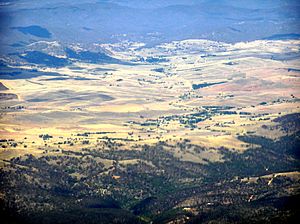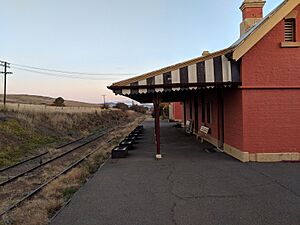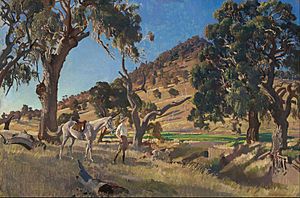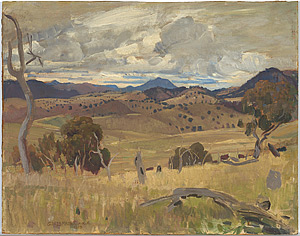Michelago facts for kids
Quick facts for kids MichelagoNew South Wales |
|||||||||||||||
|---|---|---|---|---|---|---|---|---|---|---|---|---|---|---|---|
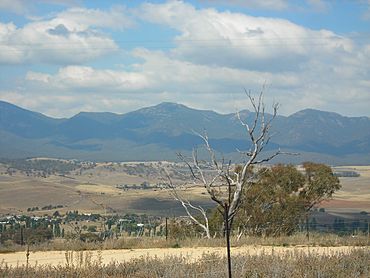
View from Loorungah, Clearview Road 2009
|
|||||||||||||||
| Population | 642 (2021 census) | ||||||||||||||
| Postcode(s) | 2620 | ||||||||||||||
| Elevation | 800 m (2,625 ft) | ||||||||||||||
| Location | |||||||||||||||
| LGA(s) | Snowy Monaro Regional Council | ||||||||||||||
| County | |||||||||||||||
| Parish |
|
||||||||||||||
| State electorate(s) | Monaro | ||||||||||||||
| Federal Division(s) | Eden-Monaro | ||||||||||||||
|
|||||||||||||||
Michelago is a small village in the Monaro area of New South Wales, Australia. It is part of the Snowy Monaro Regional Council and is about 54 kilometers (33 miles) south of Canberra. Michelago was started in the 1820s. It was on the main road from Sydney to the Snowy Mountains. The name Michelago also refers to the surrounding area for mail and population counts. In 2016, Michelago had 642 people living there.
Contents
Explore Michelago's Location
Michelago is in a valley between two mountain ranges. To the east is the Tinderry Range, and to the west is the Clear Range. A road from Michelago crosses the Tinderrys. This road eventually leads to Captains Flat, a silver mining town from the 1950s. The highest points in the beautiful Tinderry Range are about 1600 meters (5250 feet) above sea level. Michelago itself is around 800 meters (2625 feet) high.
The Murrumbidgee River flows between the village and the Clear Range. Michelago Creek runs through the village. It provides water for the people living there. The creek starts in the Tinderry Range. After passing the town, it flows into the Murrumbidgee River. Some people say Michelago marks the spot where white-backed and black-backed magpies meet on the Monaro Highway. This highway goes from Canberra to Cooma.
Michelago's Past and Early Settlers
The land around Michelago was originally home to the Ngarigo people.
Explorers named Currie and Ovens explored this area in 1823. The first European settlers arrived soon after. They were Emmanuel and Catherine Elliot, who were former convicts. In 1834, explorer Dr John Lhotsky traveled south from the Limestone Plains to Michelago. He noted that there were no churches south of Sutton Forest and no white women south of Michelago.
In 1835, 640 acres of government land at "Meccaligo" were put up for sale. By 1850, the community had a licensed inn.
Francis Nicholas Rossi, the first police superintendent for the Monaro area, built a homestead called Micilago in 1837. This large property covered 14,175 hectares (35,000 acres). In 1859, Alexander Ryrie bought the station. He married Charlotte Faunce, whose father was a police magistrate in Queanbeyan. One of their children was Granville Ryrie. He later became a General in World War I and was involved with the League of Nations.
Alexander Ryrie kept the name Micalago for his station. But he wanted the new village to be spelled "Michelago." This was to avoid confusion between his station and the town. He was influential, and so the two spellings became different. Both Michelago and Micalago are pronounced the same way. Alexander built St Thomas' church in Michelago village. Life for people in the area was very self-sufficient. They earned money from wool. They also raised cattle for meat, milk, and butter. They grew their own fruits and vegetables. They even made soap and candles by hand.
Picnic races were a big social event. Over 200 people attended the Michelago Public School picnic in 1906. From the 1930s to the 1950s, making eucalyptus oil was a good business in the Tinderry Range. A drum of eucalyptus oil was worth 100 pounds in the 1940s. Some important early families in Michelago were the Kellys, Cotters, Shanahans, Lawlers, McTernans, and Poveys. Many of their family members still live in the region today.
In October 1840, a group of five bushrangers escaped from the lockup in Queanbeyan. Police magistrate Captain Faunce chased them all the way to Michelago and caught them. On June 1, 1866, a bushranging gang, including the Clarke brothers, held up Michelago town. They drank all the alcohol from the local hotel. Then they went to their hideout in the Tinderry mountains. In February 1866, two armed men robbed the post office. They destroyed letters and stole three horses.
St Patrick's Catholic Church was a small stone building. By 1906, it was too small for the people attending. So, they decided to build a new brick church. The foundation stone for the Michelago Memorial Church was laid in October 1906. About 75,000 bricks made from local red clay were used. The roof was made of slate. The church cost £1,134 and six shillings to build. The architect was James Nangle, and the builder was Mr J. G. Taylor, both from Sydney. The building could seat 150 people. It officially opened on April 28, 1907.
Michelago's Railway Story
The railway line came to Michelago on December 7, 1887. Bernard Ferris opened a railway pub called the 'Navvies' Arms' during the construction. In the 1920s, the 'Great White Train' visited Michelago. It had fifteen special cars to encourage people to 'Buy Australian Made' products.
The railway line closed in 1989. This included the line from Queanbeyan to Cooma. From 1993 to 1997, the Australian Railway Historical Society (ARHS) ran heritage train trips to Michelago. But the tracks got worse, so services stopped at Royalla, about 23 kilometers (14 miles) north. Due to damage to old wooden bridges in floods near Queanbeyan in 2010, the ARHS is unlikely to run trains to Michelago again. The railway was cut in July 2016 when a bridge north of Michelago station was removed. To the south, the railway is also not used between Michelago and Chakola. A road resurfacing project in the 1990s also cut the railway north of Bredbo.
Important Heritage Sites
Michelago has several places listed as heritage sites. These include:
- The railway bridge over Ingalara Creek, part of the Goulburn–Bombala railway.
- The Michelago railway station, also part of the Goulburn–Bombala railway.
Michelago in Art, Poetry, and Film
The famous painting The Squatter's Daughter by George Washington Lambert was painted in Michelago. Lambert also painted Michelago Landscape. Both paintings are now in the National Gallery of Australia.
Poet David Campbell wrote a poem called The Squatter's Daughter. It was about the funerals of Granville Ryrie and his daughter in Michelago.
The artist Robert Pengilley lives and paints in the Michelago area. In 1986, a painting called Ryrie's Creek by Pengilley was given as a gift from the Australian Government to China. Another of his paintings, Storm over the Tinderrys, is at the Australian National University in Canberra.
The 1999 movie Passion, about the life of Percy Grainger, was partly filmed in Michelago. The 2004 film Somersault by Cate Shortland also had scenes filmed at the Ryrie homestead in Michelago. Scenes from the 1979 film My Brilliant Career by Gillian Armstrong were also shot there.
Facing Bushfires
In November 1957, a large bushfire in the Tinderry Range burned 90% of the nature reserve. It was not put out until December 24. In January 2003, bushfires spread from Namadgi National Park and caused a lot of damage around Michelago. This was especially true for the plants and bushland near Clearview Road and the Murrumbidgee River. The village itself was safe, but some farms and houses were destroyed. The mountains of the Clear Range were left black and bare. Another bushfire started on December 17, 2009. It burned over 9,000 hectares (22,239 acres) east of Michelago. It also destroyed three homes and a sawmill.
Notable People from Michelago
- Garrett Cotter
- Alexander Ryrie
- Granville Ryrie
- George De Salis
Future Plans for Michelago
A company from Canberra called Geocon wants to build on land in Michelago. They plan to create a new suburb that would be connected to Canberra. This development would change the village. But it could also bring new and needed services to the area.



